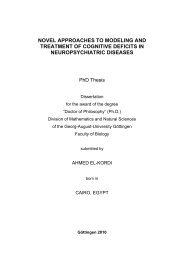Cortical and subcortical mechanisms in persistent stuttering ...
Cortical and subcortical mechanisms in persistent stuttering ...
Cortical and subcortical mechanisms in persistent stuttering ...
Create successful ePaper yourself
Turn your PDF publications into a flip-book with our unique Google optimized e-Paper software.
German version of the SSI-3 (S<strong>and</strong>rieser <strong>and</strong> Schneider, 2008; Riley, 1994), speech samples<br />
of all participants conta<strong>in</strong><strong>in</strong>g a conversation about job or school <strong>and</strong> a read<strong>in</strong>g task were<br />
videotaped (Sony H<strong>and</strong>ycam DCR-TRV16E M<strong>in</strong>i DV digital Camcorder) <strong>and</strong> audio recorded<br />
(Edirol R-09; sample rate: 16 bit/44.1 kHz; format: WAV). SSI-3 norms were adapted from<br />
Riley (Riley, 1994). Software for offl<strong>in</strong>e analysis was DivX player (DivX software, San<br />
Diego) <strong>and</strong> WavePad (NCH software, Canberra). The offl<strong>in</strong>e analysis of dysfluencies<br />
<strong>in</strong>cluded 500 syllables for the conversation <strong>and</strong> not less than 340 syllables for the read<strong>in</strong>g<br />
task. Sound prolongations, blocks (silent prolongation of an articulatory posture), sound <strong>and</strong><br />
syllable repetitions were counted as stuttered syllables. Monosyllabic words that were<br />
repeated with apparent undue stress or tension were counted too (S<strong>and</strong>rieser <strong>and</strong> Schneider,<br />
2008). Furthermore, the estimated duration of the three longest blocks <strong>and</strong> observation of<br />
physical concomitants<br />
were <strong>in</strong>cluded for the estimate of stutter<strong>in</strong>g severity <strong>in</strong> AWS.<br />
38<br />
Procedure<br />
The experiment consisted of two sessions, one for stimulat<strong>in</strong>g the left <strong>and</strong> the other for<br />
stimulat<strong>in</strong>g the right PMd. Dur<strong>in</strong>g each session participants performed one run of left <strong>in</strong>dex<br />
<strong>and</strong> one run of right <strong>in</strong>dex f<strong>in</strong>ger tapp<strong>in</strong>g before rTMS. Both runs were repeated immediately<br />
(about 30 sec) after rTMS. The order of stimulation site <strong>and</strong> h<strong>and</strong> was counterbalanced across<br />
participants. To avoid carry-over effects of the magnetic stimulation the second rTMS session<br />
was performed not less than 48 hours after the first one.<br />
Participants sat <strong>in</strong> a silent room <strong>in</strong> front of a computer keyboard connected to the computer<br />
via a PS/2 cable. The keyboard was shielded to the participant’s visual field. Participants were<br />
requested to synchronize their unimanual <strong>in</strong>dex f<strong>in</strong>ger taps with a metronome. The<br />
acoustically presented metronome signals conta<strong>in</strong>ed clicks of 10 msec duration with an <strong>in</strong>ter<br />
click <strong>in</strong>terval of 800 msec. Each experimental run comprised a cont<strong>in</strong>uous series of 56 clicks.<br />
The clicks were presented b<strong>in</strong>aurally via dynamic, closed-ear headphones (Sennheiser HD<br />
280; up to 32 dB attenuation of outside noise). Click <strong>in</strong>tensity was <strong>in</strong>dividually adjusted to a<br />
level perceived as loud by the participants. The pac<strong>in</strong>g signal was triggered <strong>and</strong> the onsets of<br />
space bar presses were recorded by us<strong>in</strong>g Eprime (http://www.pstnet.com). We quantified<br />
performance by calculat<strong>in</strong>g (1) the asynchrony, the averaged temporal distance between the<br />
onset of the pac<strong>in</strong>g signal <strong>and</strong> f<strong>in</strong>ger taps, <strong>and</strong> (2) the <strong>in</strong>ter-tap <strong>in</strong>terval (ITI)-variability, the<br />
variation of the time between two consecutive taps.



